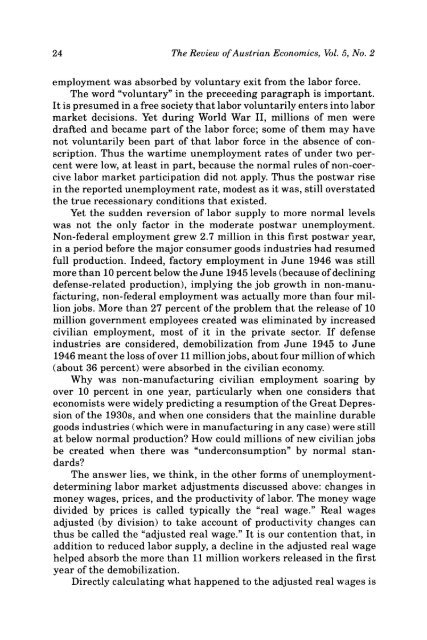Review of Austrian Economics - The Ludwig von Mises Institute
Review of Austrian Economics - The Ludwig von Mises Institute
Review of Austrian Economics - The Ludwig von Mises Institute
You also want an ePaper? Increase the reach of your titles
YUMPU automatically turns print PDFs into web optimized ePapers that Google loves.
24 <strong>The</strong> <strong>Review</strong> <strong>of</strong> <strong>Austrian</strong> <strong>Economics</strong>, Vol. 5, No. 2<br />
employment was absorbed by voluntary exit from the labor force.<br />
<strong>The</strong> word "voluntary" in the preceeding paragraph is important.<br />
It is presumed in a free society that labor voluntarily enters into labor<br />
market decisions. Yet during World War II, millions <strong>of</strong> men were<br />
drafted and became part <strong>of</strong> the labor force; some <strong>of</strong> them may have<br />
not voluntarily been part <strong>of</strong> that labor force in the absence <strong>of</strong> conscription.<br />
Thus the wartime unemployment rates <strong>of</strong> under two percent<br />
were low, at least in part, because the normal rules <strong>of</strong> non-coercive<br />
labor market participation did not apply. Thus the postwar rise<br />
in the reported unemployment rate, modest as it was, still overstated<br />
the true recessionary conditions that existed.<br />
Yet the sudden reversion <strong>of</strong> labor supply to more normal levels<br />
was not the only factor in the moderate postwar unemployment.<br />
Non-federal employment grew 2.7 million in this first postwar year,<br />
in a period before the major consumer goods industries had resumed<br />
full production. Indeed, factory employment in June 1946 was still<br />
more than 10 percent below the June 1945 levels (because <strong>of</strong> declining<br />
defense-related production), implying the job growth in non-manufacturing,<br />
non-federal employment was actually more than four million<br />
jobs. More than 27 percent <strong>of</strong> the problem that the release <strong>of</strong> 10<br />
million government employees created was eliminated by increased<br />
civilian employment, most <strong>of</strong> it in the private sector. If defense<br />
industries are considered, demobilization from June 1945 to June<br />
1946 meant the loss <strong>of</strong> over 11 million jobs, about four million <strong>of</strong> which<br />
(about 36 percent) were absorbed in the civilian economy.<br />
Why was non-manufacturing civilian employment soaring by<br />
over 10 percent in one year, particularly when one considers that<br />
economists were widely predicting a resumption <strong>of</strong> the Great Depression<br />
<strong>of</strong> the 1930s, and when one considers that the mainline durable<br />
goods industries (which were in manufacturing in any case) were still<br />
at below normal production? How could millions <strong>of</strong> new civilian jobs<br />
be created when there was "underconsumption" by normal standards?<br />
<strong>The</strong> answer lies, we think, in the other forms <strong>of</strong> unemploymentdetermining<br />
labor market adjustments discussed above: changes in<br />
money wages, prices, and the productivity <strong>of</strong> labor. <strong>The</strong> money wage<br />
divided by prices is called typically the "real wage." Real wages<br />
adjusted (by division) to take account <strong>of</strong> productivity changes can<br />
thus be called the "adjusted real wage." It is our contention that, in<br />
addition to reduced labor supply, a decline in the adjusted real wage<br />
helped absorb the more than 11 million workers released in the first<br />
year <strong>of</strong> the demobilization.<br />
Directly calculating what happened to the adjusted real wages is

















